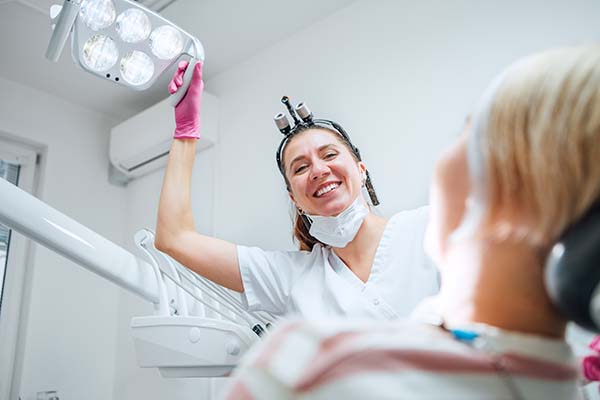A Restorative Dentist Can Repair Teeth

What can a restorative dentist do for patients? This is a big question with a lengthy answer. However, in a nutshell, restorative dentistry may be a good fit for many people.
Patients should consider if they have problems with their teeth or if their teeth feels loose, wobbly, or if they get cavities easily. Restorative dentistry can help with these types of issues to help people get back to looking and feeling their best.
Whether it's fixing a cavity, getting rid of plaque that leads to more decay, improving the appearance of the smile through cosmetic dental work like bonding and veneers (a thin shell made out of porcelain), or building up tooth enamel with fluoride treatments. These types of dentists are experts in restoring both function and beauty of teeth.
We are happy to inform our patients about what this type of dentistry can do for their overall health and tooth function. Let us take a closer look at understanding what this type of treatment offers and to better learn which type of person benefits from these treatment options.
What is restorative dentistry?
These dentists provide the full range of dental services, from primary preventative care and hygiene to complex procedures such as root canals and implants. They focus on improving function and appearance by restoring teeth to health with fillings or crowns (caps). These include:
- Cavities – Restoring the tooth with fillings
- Loose or wobbly teeth – Using crowns to stabilize the teeth and improve their appearance
- Chips, cracks, fissures – Repairing these problems by bonding (using a composite resin) veneers (porcelain shells placed over the top of existing teeth), implants, or other restoration options
- Dental implants – An implant is a small screw that gets put into the jawbone. It will eventually fuse to become part of the bone, creating an anchor for crowns and bridges. The dentist can also use implants in conjunction with dental appliances such as dentures or braces
What can I expect?
When patients come in for their first appointment, the dentist will talk with them about what is happening and explain the treatment options available. This evalaution should be very thorough as it determines the next step of the entire treatment plan. The dentist may take x-rays of the teeth to get a better look at how they are positioned or working together as a unit. This thorough process allows them to plan which procedures would be best suited for the patient so that the teeth can be restored appropriately.
Most patients go home with a temporary filling until the permanent one can be placed after the tooth has healed properly. Patients will have several appointments, depending on their needs and how many procedures need to take place for them to get your smile looking great again.
How do I know if it is right for me?
If a patients is ooking to restore teeth that are already damaged, then this type of dentistry may be right for them. Of course, going in for a complete evaluation will ultimately determine if this is a good choice for a particular patient.
Patients should look at their smile and consider which of the following apply:
- Their tooth is chipped or cracked
- They have lots of cavities (more than six)
- Their fillings need replacing after less than ten years
- Their teeth are wobbly or loose
Other considerations may include haing stains, chips, cracks (including root canal damage), fissures (a groove in the tooth that can cause sensitivity and pain) on the front teeth. These problems need to be addressed by a dentist who uses advanced techniques to make sure the teeth are healthy and have the best possible appearance.
Remember that only a dentist can determine which type of treatments work best for each patient. While these are simple guidelines, a consultation with a dentist will determine if restorative dentistry is right for a particular person.
How can I learn more?
Restorative dentistry is a great option for many people suffering with a variety of dental issues. However, this may not be the best solution for everybody. If a patient is interested in learning how this type of dentistry could help restore their smile, make an appointment with a dentist today! They will be able to explain all the procedures available, their costs, expected results, treatment timeframes (about six months), and whether or not a articular patient is a good candidate for treatment.
Request an appointment here: https://aestheticsmiles.com or call Aesthetic Dentistry of Noe Valley at (415) 493-9143 for an appointment in our San Francisco office.
Check out what others are saying about our dental services on Yelp: Restorative Dentist in San Francisco, CA.
Related Posts
Individuals who have broken teeth may suffer from a lack of self-confidence. Whether you broke your tooth eating something hard or experienced trauma that directly or indirectly impacted the tooth, it is a good idea to get it fixed. Treating a broken tooth has not only aesthetic benefits but also provides dental and overall health…
Restorative dentistry is the process of restoring damaged or missing teeth. You have had a form of dental restoration if you have ever had bridges, crowns, or fillings. Dentists want to improve or maintain your smile while preventing future dental complications. Restorative procedures need care and attention to detail. Therefore, only qualified dental professionals should…
Almost everyone understands the importance behind brushing your teeth and the role tooth enamel plays in maintaining dental health.However, many underestimate the unique quality that enamel has and don’t have a complete understanding of how enamel works, which in return makes it far more difficult to take the necessary precautions to ensure they maintain healthy…
Tooth decay or cavities happens when bacteria accumulate in your mouth create acids that abrade your teeth. If left untreated, tooth decay may eventually worsen to infections, toothache, and possible tooth loss. The decay process starts with hidden damage to the teeth enamel and gradually eats into the internal layers of the tooth, before reaching…


